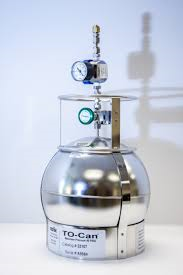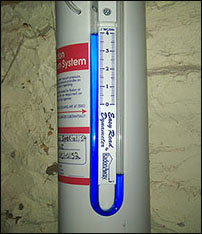Vapor Intrusion Resources for Property Owners, Occupants & The Public
Certain chemicals that are spilled or discharged into the environment can emit gases, or vapors, that move through the soil. Contaminated vapors may enter a house or building through cracks, holes, drains and other small openings in a basement floor, wall or foundation slab - even with new construction. This is called vapor intrusion. It is similar to how radon, a naturally occurring gas, enters a house or building.
Contaminated vapors, which may be odorless and colorless, can accumulate and become a potential health risk.
Whether you are a property owner, landlord, occupant or member of the public, it is important to understand the basics of how vapor intrusion can affect you and your community.
- Vapor Intrusion 101 [exit DNR] or Intrusión de Vapor 101 (Spanish version) [exit DNR] - This video introduces the concept of vapor intrusion to people who may be unfamiliar with it by showing the root cause, how it spreads underground, and what can be done about it.
- Former Dry Cleaners – The Hidden Risk [exit DNR] - This video for municipal leaders brings to light the health risks associated with historical dry cleaners where no environmental investigation or cleanup has taken place.
- The Vapor Intrusion Prevention & Partnership Toolkit webpage provides tools for minimizing vapor intrusion risks in your community.
- Factsheets
-
Vapor Intrusion Resources
Summa canisters are often used to collect a vapor sample for laboratory analysis. Why Test for Vapor Intrusion? (RR-953) [PDF] or ¿Por Qué Probar la Intrusión de Vapor? (RR-953a: Spanish version) [PDF] - If a nearby property is contaminated, it is possible for contaminated vapors to move through the soil and enter your house or building. Sampling and testing determines whether or not contaminated vapors are present in indoor air.
What to Expect During Vapor Intrusion Sampling (RR-954) [PDF] - Environmental professionals utilize different methods to test for contaminated vapors, which may involve drilling one or more small holes into a basement floor or foundation, collecting soil vapor from under the building, and sending the soil gas sample to a specialized laboratory for analysis. Samples of indoor air may also be collected and sent to the laboratory.
Understanding Chemical Vapor Intrusion Testing Results (RR-977) [PDF] - Samples collected from your property are tested by a certified laboratory. The DNR uses the laboratory report to evaluate whether people in a building may be exposed to contaminated vapors.
Mitigation: Protection from Vapor Intrusion (RR-094) [PDF] or Mitigación: Protección Contra La Intrusión De Vapor (RR-094a: Spanish version) [PDF] - When contaminated vapors are present in the air below a building, the indoor air can become contaminated, which may have the potential to cause health problems. Systems known as vapor mitigation systems can be installed in the building to prevent contamination from moving to the indoor air.
Environmental Contamination & Your Real Estate (RR-973) [PDF] - When soil or groundwater contamination is discovered, property owners may ask how the contamination will impact the market value of the property, and property owners may be required by Wisconsin law to disclose certain conditions about a property impacted by environmental contamination before selling the property.
What is Vapor Intrusion? - The U.S. Environmental Protection Agency (EPA) website on vapor intrusion includes additional information and resources.
- Maintenance Requirements
-
Vapor mitigation on your property
The manometer measures suction created by the vapor mitigation system fan. The uneven levels of the liquid indicate the system fan is running, but cannot be used exclusively to determine the effectiveness of the system. If the vapor mitigation was required as part of an environmental cleanup under ch. 292, Wis. Stats., the continued operation and maintenance of vapor mitigation can be made a continuing obligation for a property ( ch. 726, Wis. Adm. Code), and the current property owner must comply with these requirements ( ch. 727, Wis. Adm. Code).
If operation and maintenance of a mitigation system is a continuing obligation on a property, the specific requirements should be included in a letter issued from the DNR, and instructions for care and inspection of the system should be summarized in the maintenance plan. Both the letter and the maintenance plan should be available at the property.
Who can help?
Vapor mitigation systems are similar or equivalent to radon mitigation systems. The Wisconsin Department of Health Services (DHS) maintains a list of radon mitigation contractors that have passed national proficiency standards: Radon Mitigation: Wisconsin Certified Radon Mitigation Contractors [exit DNR]. If help is needed with repairs or replacement of a mitigation system, the DNR strongly suggests work be performed by contractors who have been certified by the National Radon Proficiency Program (NRPP).
Copies of DNR letter or maintenance plan
Electronic copies can be downloaded from Wisconsin's Remediation and Redevelopment Database (BRRTS on the Web). BRRTS on the Web (BOTW) is a database organized by BRRTS activity number, which is assigned to the property that was the source of the contamination. (Note: Your address may be the same or different than the address listed in BOTW, depending on if the property was the original source or an offsite affected property). The DNR letter that summarizes the continuing obligations (requirements) and maintenance plan for a property are found in within the closure or registry packet.
How to use BOTW to find the maintenance plan and DNR continuing obligations letter for a property
- Go to Wisconsin's Remediation and Redevelopment Database
- If you know the BRRTS activity number for the site that was the source of the contamination:
- Click on the link for BRRTS on the Web
- Enter the number into activity number search field
- If you don’t know the BRRTS activity number:
- Click on the link for RR Sites Map
- Use the zoom tools or search for address tool to find your property
- Search for a BRRTS site on or near your property boundaries*.
- Using the identify tool click on the point to get more information, including the BRRTS activity number
- Click on the link to the listing on BRRTS on the Web
*Note: If your property does not include a BRRTS site, it is likely you are an offsite affected property and you will need to find the BRRTS site located near your property on the map. If there are multiple BRRTS sites surrounding your property, you may need to review several BRRTS activity numbers to find the closure packet that has your maintenance plan.
- Find a link to a PDF of the registry or closure packet posted on BRRTS on the Web after closure.
- Search through the packet to find the maintenance plan for your property.
- Print out the pages containing a copy of your maintenance plan.
Questions? See a list of DNR contacts on the right side of this page.
- Health Information
-
The DNR partners with the Wisconsin Department of Health Services (DHS) and local health departments regarding short-term (acute) and long-term (chronic) risks to human health related to vapor intrusion, and DNR partners may make recommendations on appropriate immediate and interim actions (e.g., ventilation, mitigation) at affected sites. DHS and local health departments assist the DNR, responsible parties and environmental consultants with health risk communications, including supportive literature.
DHS’ fact sheet specific to the health concerns of trichloroethylene (TCE) in the air of buildings where the chemical may have unexpectedly traveled (e.g., residences, schools, daycares, businesses that do not use TCE).
DHS two-page fact sheet specific to the health concerns of TCE when used as a chemical in the workplace:
- TCE in the Workplace
- TCE en el lugar de trabajo (Spanish version)
- TCE Nyob Rau Hauv Qhov Chaw Ua Hauj Lwm (Hmong version)
For more information about vapor intrusion and health, visit the DHS website or view their vapor intrusion fact sheet:
Additional technical publications regarding vapor intrusion are available on the Vapor Intrusion Resources for Environmental Professionals webpage.
- Contacts
-
For more information, contact DNR's vapor intrusion experts.


